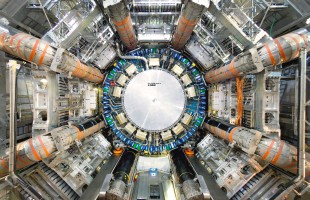For the first time, physicists have been able to directly observe neutrinos produced in proton collisions at the LHC accelerator at CERN. This was announced by the FASER experiment at the Moriond winter conference in Italy.
According to Brian Peterson of the experiment, it is sunshine proof that FASER sees neutrinos created in the ATLAS detector when protons collide there. At 16 sigma, the signal has extremely high statistical reliability. In particle experiments, five sigma is considered foolproof experimental evidence.
The FASER experiment is a relatively small detector set up in line with the ATLAS detector in the circular LHC accelerator. ATLAS itself has a blind spot in that direction because the accelerator tube is in the way. The FASER detector is some 480 meters away in a service tunnel, in a place where the accelerator tube is no longer in the way.
The experiment, which also involves a number of Nikhef physicists, was built in 2021 using mostly reused equipment from other experiments. From Nikhef, ATLAS physicist Lydia Brenner, among others, is collaborating on FASER.
Dark photons
The main goal of the experiment is the search for so-called dark photons. These are hypothetical particles that may play a role in the relationship of matter to dark matter. Dark matter is the unknown matter that causes up to four-fifths of all gravity in the universe.
In the measurements with FASER, no signal that could be a dark photon has been seen so far. This zero result, physicists say, already provides important limits to the possible properties of dark photons.
That neutrinos, almost massless uncharged elementary particles without many interactions, arise in particle processes is not in itself new or special. However, their existence has so far always been inferred from the lack of energy in collision processes.
Highest energy
FASER saw 153 (+/- 41) neutrinos pass through in a year of measurements that could only have come from collisions in the ATLAS detector at the LHC. This is exactly as expected. The ghost particles leave traces in the device’s sensors.
Some of the observed neutrinos have the highest energy seen so far in physical experiments. Only neutrinos from the cosmos measured in, for example, the ICECUBE detector at the South Pole have much higher energies.
Nikhef physicist Lydia Brenner of ATLAS and FASER is delighted with the first results. “Two incredibly precise results from the first limited data set we analyzed,” she says. At the Moriond conference the result was called a highlight of the day.
An article on the first FASER measurements will soon appear on the arxiv website. The slides from the talk at the Moriond conference have already been published.
